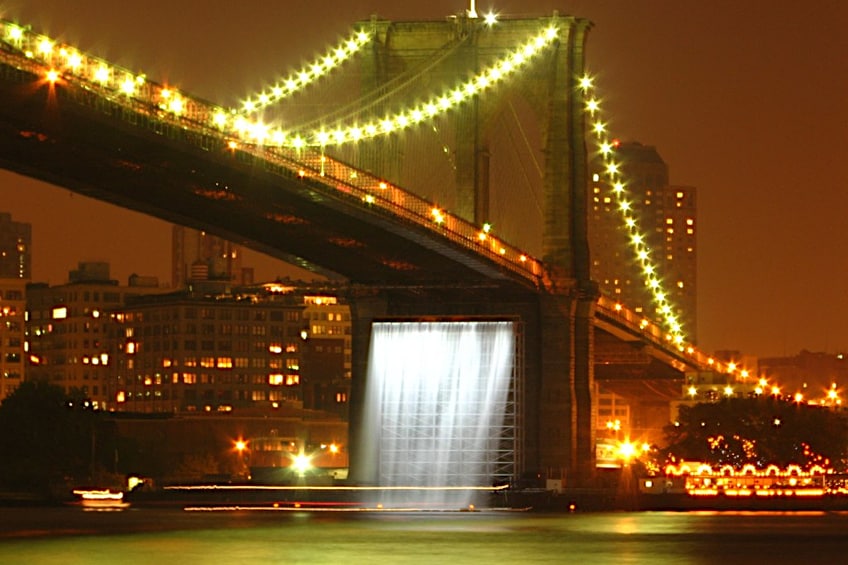Environmental Artists – Creative Critics of the Anthropocene
As global temperatures continue to rise, environmental concerns for the earth and all that it sustains grow more urgent. Artists were among the first in society to respond to scientists’ warnings about the calamities our planet will face if humanity does not start to live more sustainably. Environmental artists started using innovative materials to raise awareness about climate change and future threats. In this article, we briefly introduce ten of our time’s most significant and inspiring Environmental artists.
Contents
- 1 What Is Environmental Art?
- 2 Ten Environmental Artists You Should Know
- 2.1 Agnes Denes (1931 – Present)
- 2.2 Nils-Udo (1937 – Present)
- 2.3 El Anatsui (1944 – Present)
- 2.4 Ana Mendieta (1948 – 1985)
- 2.5 Andy Goldsworthy (1956 – Present)
- 2.6 John Akromfrah (1957 – Present)
- 2.7 Maya Lin (1959 – Present)
- 2.8 Chris Jordan (1963 – Present)
- 2.9 Olafur Eliasson (1967 – Present)
- 2.10 Mary Mattingly (1967 – Present)
- 3 Frequently Asked Questions
What Is Environmental Art?
Our epoch has been defined by anthropologists and earth scientists as the Anthropocene era. Scientists argue that the term “Anthropocene” refers to a geological unit of time, where the Greek root word for the term “anthropo” simply means “human”. The term thus defines our era as a global unit of time where the human impact (interference) on the earth has been so severe that it is resulting in devastating consequences, including climate change, imbalances in the earth’s ecosystems, and the rapid extinction of entire animal, insect, and plant species.
Environmental art can be described as art that responds to humanity’s negative impact on the earth and ecological threats posed in the Anthropocene era.

Ten Environmental Artists You Should Know
Society is becoming increasingly aware of the challenges of the Anthropocene era and the degradation of our natural environments by the human hand. With this realization, more and more artists are beginning to respond to the interconnectivity that we share with the earth and its ecosystems. There have, however, been artists talking about exactly these concerns since the mid-20th century. Below we highlight ten of the most prominent artists whom we see as the forerunners of the Environmental art movement.
Agnes Denes (1931 – Present)
| Nationality | Hungarian, American |
| Date of Birth | 31 May 1931 |
| Associated Art Movements | Conceptual art, and Environmental art |
| Most Famous Works |
|
Agnes Denes is arguably the most well-known Environmental artist in the world. Born in 1931 and engaged with the subject of environmental concern since the 1960s, Denes is considered one of the foremost pioneers of Environmental art. Throughout her career, she has explored natural landscapes, transforming dry and desolate spaces into ones thriving with life.
Her work is highly collaborative and borders on activism, which left people at the time struggling to define and categorize her work and practice. Denes’s work is site-specific, conceptual, and ambitious. One of her most famous works, which afforded her international acclaim, is Wheatfield — A Confrontation (1982).
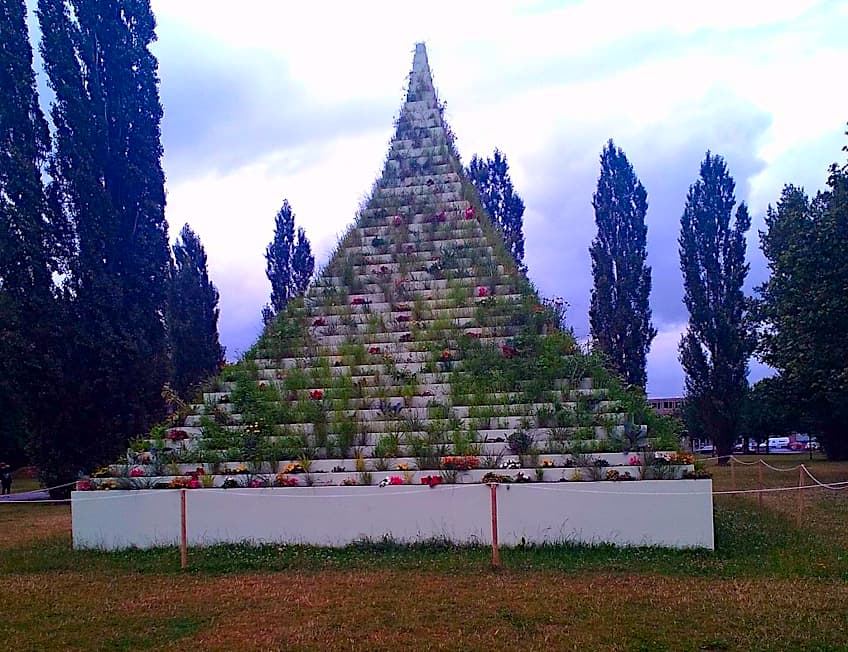
In Wheatfield – A Confrontation, Danes cultivated a two-acre wheat field on a deserted plot of land that is overlooked by the World Trade Center. Many collaborators helped over a period of three months to prepare the soil, plant, and harvest the wheat. By revitalizing a plot of urban wasteland in front of a building that is a symbol of power, Denes seemed to ask the policymakers and other powerful people important questions about the importance of environmental conservation, wealth divides in the city, and the prioritizing of urban development over natural rehabilitation.
The plot of land has since been developed into the Battery Park City neighborhood and the work only lives on in photographs and people’s memory.
Nils-Udo (1937 – Present)
| Nationality | German |
| Date of Birth | 1937 |
| Associated Art Movements | Environmental art, and Land art |
| Most Famous Works |
|
Most famous for his colossal sculptures of nests, Nils-Udo is one of the most famous figures in the early stages of the Environmental art movement. Since the 1970s, he has created large, site-specific installations in natural landscapes. His work considers humanity’s impact on the natural world and even though his work technically intervenes in natural settings, he executes his work with the utmost care and respect for the environment.

Working with natural materials, such as snow, sticks, leaves, berries, water, stones, and flowers, Nils-Udo’s work is temporary, memorialized only in photographs. His utopian and fantastical natural installations have been created in over 40 countries, where he draws inspiration from all the different topologies of each unique landscape.
El Anatsui (1944 – Present)
| Nationality | Ghanaian |
| Date of Birth | 4 February 1944 |
| Associated Art Movements | Contemporary art, Junk art, and Post-Minimalism |
| Most Famous Works |
|
The internationally acclaimed artist El Anatsui has been transforming simple found materials into stunning assemblages that have captivated his audience since he first started making art. Anatsui was born in Ghana and currently lives and works in Nigeria. While terms like “recycling” and “zero waste” are rather new in our societies, Anatsui has been embracing these practices throughout his career. His sculptural painting-like collaged works become large installations that transcend categories and often include waste material, such as disregarded bottle caps, old tins, driftwood, nails, railway sleepers, and cassava graters.

Anatsui’s works are layered with meaning. Not only is he transforming waste into something beautiful and striking, but he is also commenting on Africa’s colonial history, global consumerism, and the problematic practices of extraction and waste.
Among his most famous works are a series of monumental wall hangings made from caps, seals, and cans reclaimed from Nigerian alcohol distilleries, which originated through trade with Europe. To create these works, thousands of metal pieces and caps are flattened, folded, and woven together with copper wire, resulting in massive intricate works layered with histories of labor, economic exchange, exploitation, and waste.
Ana Mendieta (1948 – 1985)
| Nationality | Cuban-American |
| Date of Birth | 18 November 1948 |
| Date of Death | 8 September 1985 |
| Associated Art Movements | Contemporary art, Body art, Land art, and Performance art |
| Most Famous Works |
|
Ana Mendieta was a Cuban-American contemporary artist, known for her performance art, sculptures, paintings, and video work. She was born in Cuba but fled her country after the Cuban revolution when she was 12 years old. In 1961 she relocated to Iowa as part of a US government asylum program for Cuban youth. She would go on to study an undergrad in painting and an MFA in Intermedia studies at the University of Iowa. She made work during the 1970s and early 1980s, but sadly passed away in 1985 at age 37.
Mendieta is arguably most famous for her “earth-body” artworks. She was among the early feminist artists who explored the female body’s relationship to nature and natural environments. Her most famous series addressing this relationship is her Siluetas series (1973-1980) where she used her body to create imprints in natural landscapes. While these works were temporary, they were documented in striking photographs.
The silhouette trace left in the earth reminds one of the absence of her body, a theme deeply connected to her experience of exile as a child. Explaining her connection to these landscapes, Mendieta explains: “Through my earth/body sculptures I become one with the earth…. I become an extension of nature and nature becomes an extension of my body.”
Andy Goldsworthy (1956 – Present)
| Nationality | British |
| Date of Birth | 26 July 1956 |
| Associated Art Movements | Conceptual art, and Environmental art |
| Most Famous Works |
|
Known predominantly as a Land artist and for his site-specific sculptures, Andy Goldsworthy is one of the leading early Environmental artists. Goldsworthy was born in England and worked on different farms from the age of 13. The repetitive nature of farm work inspires his sculptural process, which relies heavily on routine and rhythm. He once said that his artistic process is “like picking potatoes”.
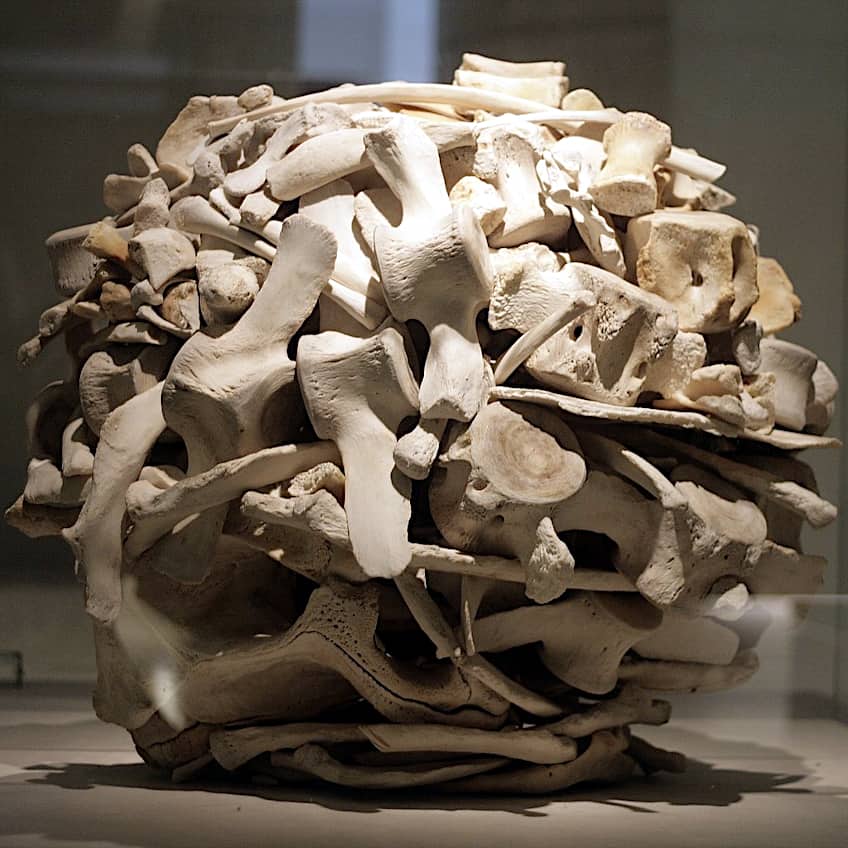
Goldsworthy uses natural materials in his work, like stone, clay, flower petals, and wood, and claims that his main goal is to foster a connection between his viewers and nature. Viewing nature as a collaborator in his work, Goldsworthy engages with the natural cycles of creation and decay. Through his work, he often celebrates nature’s organic patterns and brings people’s attention to the beauty of the natural world.
John Akromfrah (1957 – Present)
| Nationality | Ghanaian-British |
| Date of Birth | 4 May 1957 |
| Associated Art Movements | Contemporary filmmaking, Postcolonial art, and Environmental art |
| Most Famous Paintings |
|
Born in 1957 in Accra, Ghana, and relocating to the United Kingdom in xxx, John Akromfrah is a world-renowned British pioneering artist and filmmaker. He is most famous for his installations of multi-channel videos that critically engage with the legacy of colonialism, the African diaspora, and the global environmental crisis.
His films incorporate original and archival footage to create films with layered narratives that reflect on how past and present influence current crises around human equality and environmental degradation.
Akromfrah co-founded the Black Audio Film Collective in the 1980s, a ground-breaking collective with a highly unique and experimental style of filmmaking that highlights the black diaspora living in the United Kingdom. Of his most famous works is Vertigo Sea (2015), which highlights the Atlantic slave trade and cruel violence of whale hunting. Purple (2017) focuses on the devastating effect of climate change on humans and nature, and Four Nocturnes (2019), a film that maps the declining elephant populations in Africa and the layered history of Ghanaian politics.
Maya Lin (1959 – Present)
| Nationality | American |
| Date of Birth | 5 October 1959 |
| Associated Art Movements | Minimalism, Post-Minimalism, Earth art, and Environmental art |
| Most Famous Works |
|
Maya Lin is an American landscape architect and contemporary artist. When she was only 21 years old, Lin won a contest to design the Vietnam Veterans Memorial in Washington. Even though the monument remains Lin’s best-known work, she has also been an environmental activist throughout her career, and this ethos has long permeated her work. The critical engagement with site and place is at the heart of Maya Lin’s work, which reflects systems of nature and encourages her audience to contemplate the complexity and serenity of the natural world.
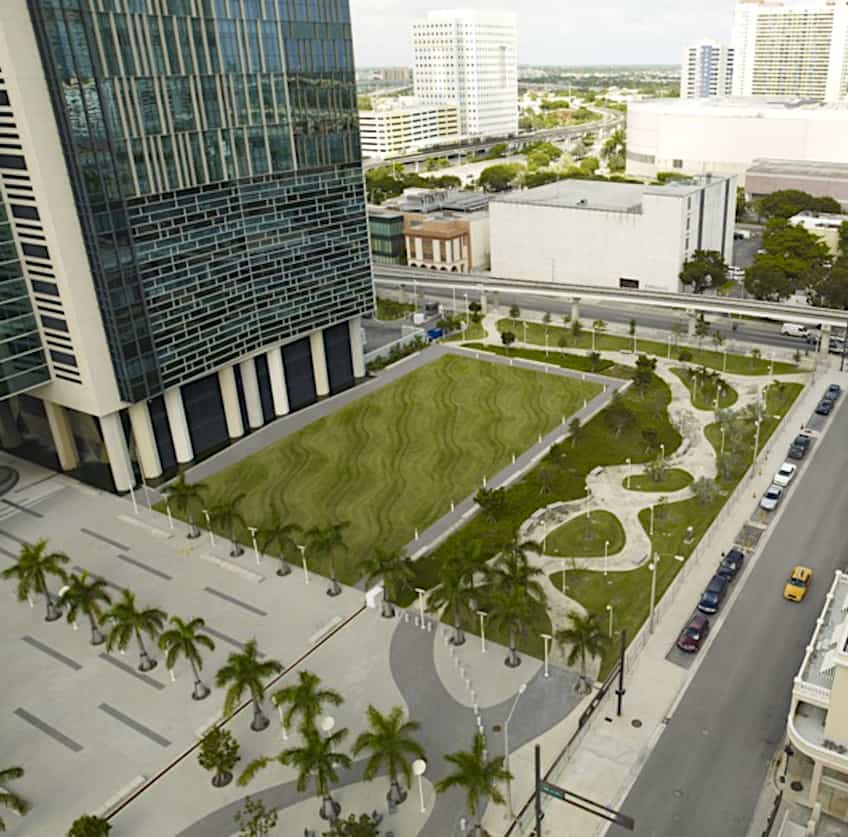
One of Lin’s large-scale installations, called Ghost Forest, was realized in May 2021 when the artist planted 49 massive cedar trees in Madison Square Park, Manhattan. The trees, however, were dead and the artist salvaged them from New Jersey’s Pine Barrens. The trees, like many others around the world, are dying due to a loss of biodiversity caused by insect infestations and saltwater infiltrations caused by rising sea levels. Planted in the greenery of the park, the dead trees serve as a reminder of the destructive effects of climate change.
Chris Jordan (1963 – Present)
| Nationality | American |
| Date of Birth | 1963 |
| Associated Art Movements | Environmental art |
| Most Famous Series of Works |
|
Chris Jordan, who originally trained as a lawyer, is a Seattle-based artist who uses photography to raise awareness of humanity’s effect on the planet and natural ecosystems. His most famous work highlight’s the damage caused by the consumerist culture that most of humanity is so entrenched in. His images function on their shock value and can be quite unsettling to view. The discomfort caused by his images communicates a strong message of the unconscious habits that most of humanity partakes in every day, which has devastating consequences in the natural environment that most of us are otherwise unaware of.
Of his most famous series of photographs is Midway: Message from the Gyre (2009–2013), which showcases the rotting carcasses of baby Laysan albatrosses. The baby birds’ stomachs are filled with tiny pieces of plastic that their parents fed to them, mistaking it for food floating in the ocean. Related to the same topic, Jordan created a documentary film called The Midway Film Project (2017). The film was funded by Kickstarter in 2012 when the proposed project received over $100,000 in donations from invested people in the public.
Olafur Eliasson (1967 – Present)
| Nationality | Icelandic-Danish |
| Date of Birth | 5 February 1967 |
| Associated Art Movements | Contemporary art, and Environmental art |
| Most Famous Works |
|
Born in Denmark in 1967, Eliasson moved to Iceland at the age of four when his parents got divorced. His father was a landscape painter and fostered Eliasson’s passion for art and nature from a young age. A year after graduating from the Royal Danish Academy of Fine Arts in Copenhagen, Eliasson had his first solo show. Eliasson established his experimental studio, called Studio Olafur Eliasson, in Berlin in 1995. The studio functions as a kind of laboratory and consists of a team of collaborators and scientists from different fields that assist the artist in realizing his ambitious ideas.

Eliasson is best known for his sculptural and immersive large-scale installations that engage with natural elements such as light, water, and temperature. In 2003, Eliasson became a household name when he represented Denmark at Venice Biennale and later that year installed The Weather Project, arguably his most famous work to date, in the Turbine Hall of Tate Modern in London. In the work, Eliasson created an entire weather system of a fictional landscape with a massive looming sun made by thousands of light bulbs with haze machines that formed clouds of fog.
Another seminal work by the artist is his Ice Watch (2014), where the artist placed 30 massive blocks of ice taken from the melting glaciers of Iceland and transported them to London. The ice blocks were left to melt in front of the Tate Modern and served as a warning of the severity of climate change. The work evoked rapid public response.
Mary Mattingly (1967 – Present)
| Nationality | American |
| Date of Birth | 8 September 1978 |
| Associated Art Movements | Contemporary art, and Environmental art |
| Most Famous Works |
|
Mary Mattingly is an American multidisciplinary artist based in Brooklyn. She uses the mediums of photography, performance, architecture, and sculptural ecosystems to address the urgency of climate change, notions of displacement, and the need for sustainable living. Mattingly’s work not only seeks to raise awareness of these issues but also provides solutions for an alternative way of living.
She is well-known for her works where she bundles together personal and consumerist items into enormous “boulders”, contained by networks of threads. She then uses these massive sculptural objects in her performances, for instance in Proposals (2012 – 2014) and Blockades, Boulders, Weights (2014).
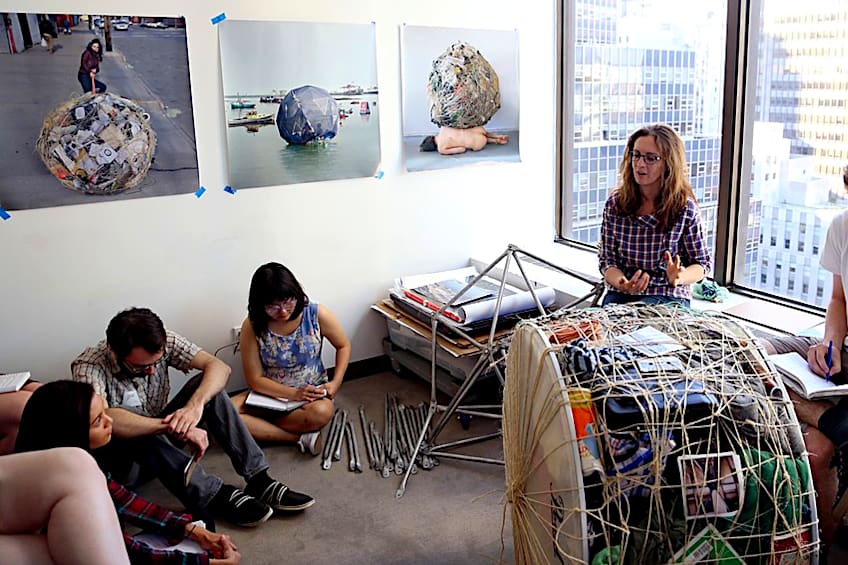
Mattingly is arguably most famous for her architectural/sculptural works, like Waterpod (2009) and Swale (2016). Swale (2016) is an especially ambitious project in which Mattingly converted an entire barge in New York City into an edible landscape that anyone can forage. This “foodway” that Mattingly created allows people from the public, for the first time in over 100 years, to forage freely in a New York City Parks piece of land. Her work is ambitious with a multimedia approach that highlights the way we can have a restorative relationship with nature.
This article briefly introduced ten artists who are leading the conversation about climate change and our relationship with the planet. These artists highlight the interconnectivity we share with the earth, its resources, and all other species who live here. By raising awareness through their art, Environmental artists are striving for a future where partial healing of our planet’s ecosystems is still possible.
Frequently Asked Questions
What Is Environmental Art?
Environmental art includes all forms of art that either consider its environmental footprint and/or address issues around environmental awareness. Environmental artists often use sustainable materials in the making of their work and might address concerns around climate change and humanity’s negative impact on the earth in the Anthropocene era. Many contemporary Environmental artists collaborate with other arts industries, such as film, music, fashion, and even architecture in the realization of their Environmental art projects.
Who Are the Most Well-Known Environmental Artists?
This article introduced ten artists who have been internationally acclaimed for their significant contribution to Environmental art. Of these artists, the most well-known artists include Agnes Denes, Nils-Udo, Andy Goldsworthy, and Olafur Eliasson.
Jordan Anthony is a Cape Town-based film photographer, curator, and arts writer. She holds a Bachelor of Art in Fine Arts from the University of the Witwatersrand, Johannesburg, where she explored themes like healing, identity, dreams, and intuitive creation in her Contemporary art practice. Jordan has collaborated with various local art institutions, including the KZNSA Gallery in Durban, the Turbine Art Fair, and the Wits Art Museum. Her photography focuses on abstract color manipulations, portraiture, candid shots, and urban landscapes. She’s intrigued by philosophy, memory, and esotericism, drawing inspiration from Surrealism, Fluxus, and ancient civilizations, as well as childhood influences and found objects. Jordan is working for artfilemagazine since 2022 and writes blog posts about art history and photography.
Learn more about Jordan Anthony and about us.
Cite this Article
Jordan, Anthony, “Environmental Artists – Creative Critics of the Anthropocene.” artfilemagazine – Your Online Art Source. March 30, 2023. URL: https://artfilemagazine.com/environmental-artists/
Anthony, J. (2023, 30 March). Environmental Artists – Creative Critics of the Anthropocene. artfilemagazine – Your Online Art Source. https://artfilemagazine.com/environmental-artists/
Anthony, Jordan. “Environmental Artists – Creative Critics of the Anthropocene.” artfilemagazine – Your Online Art Source, March 30, 2023. https://artfilemagazine.com/environmental-artists/.


